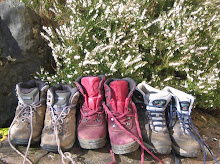Our most recent Mull Magic Wildlife Walks have taken us to remote Loch Buie, the beautiful and fertile ‘Garden of Mull


This ‘Cult of the Dead’ that specialised in the erection of stone monuments probably had its source in the Middle East and North Africa , where another of Lochbuie’s attractions, the Fallow Deer originated from. One of only two herds of this charming small deer to be found on the island, we were fortunate to locate a small party hiding in the vegetation in a field adjacent to the Standing Stones. Unlike the more abundant Red Deer Red Deer
The isolation of Mull ’s South-eastern corner makes it an ideal venue in which to search for some of the island’s most sought after wildlife. With around 120 individuals in residency around the Isle of Mull’s coastline, the Otter is a regular feature in the day of the island’s wildlife spotters. Having not fallen victim to the persecution and pollution that drove their mainland counterparts to the verge of extinction, the Isle of Mull boasts a quite exceptional population of Otters. Away from the relative hussle and hassle of the main road artery on Mull , the peace and tranquillity of life at Lochbuie seems to suit this adorable animal to perfection. Our patience has been rewarded recently with some of the best- ever encounters that Mull Magic has had with these marvellous mammals, as they hunted among the shoreline seaweed in search of small fish and crabs.
One of the most common sights around the Mull coast in Winter is the imposing frame of Great Northern Divers. These large waterfowl arrive in Autumn from their breeding haunts in Greenland and Iceland
Lochbuie is steeped in history and we always try to make a point of calling in to one of the area’s greatest treasures, a small Episcopal church built in 1876 and consecrated to St Kilda. The building may not look like anything special from the outside and we are sure that many visitors miss out on its charm on their way to 15th Century Moy Castle, which continues to disappoint with its (necessary) mask of scaffolding. Juxtaposed with its near neighbour, the Lochbuie Stone Circle, the Chancel in the Church of St Kilda houses a wonderfully impressive Crucifix, carved by Joseph Mayer, who played the role of the Saviour in the Oberammergau passion play. When it’s creator died on the 1st December 1903, the late Murdoch Maclaine of Lochbuie purchased the Crucifix and had it housed in its present position. Regardless of your religion or none, this little church, with its colourful stained glass depictions of Saints, is but another gem in the already gold-encrusted crown of this ‘far-away’ part of our island home.
Lochbuie is steeped in history and we always try to make a point of calling in to one of the area’s greatest treasures, a small Episcopal church built in 1876 and consecrated to St Kilda. The building may not look like anything special from the outside and we are sure that many visitors miss out on its charm on their way to 15th Century Moy Castle, which continues to disappoint with its (necessary) mask of scaffolding. Juxtaposed with its near neighbour, the Lochbuie Stone Circle, the Chancel in the Church of St Kilda houses a wonderfully impressive Crucifix, carved by Joseph Mayer, who played the role of the Saviour in the Oberammergau passion play. When it’s creator died on the 1st December 1903, the late Murdoch Maclaine of Lochbuie purchased the Crucifix and had it housed in its present position. Regardless of your religion or none, this little church, with its colourful stained glass depictions of Saints, is but another gem in the already gold-encrusted crown of this ‘far-away’ part of our island home.







No comments:
Post a Comment